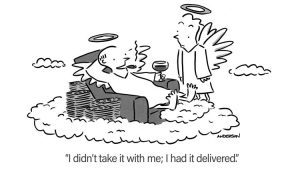American churches may be facing a fundraising reckoning. The word “recession” is on everyone’s mind. The stock market looks like a roller coaster. Fewer people are in the pews, and fewer dollars are in the collection basket. An entire generation of older, more generous parishioners is passing. And so far, “The Great Wealth Transfer” has yet to fill anyone’s collection plates to the brim (although that will change). Download Latest Stats on Church Giving (PowerPoint Show) Add to those challenges the historical fundraising problems that churches face: a reluctance to discuss money; a disconnect between the clergy, leadership, and laypeople; and an unfamiliarity with planned giving programs and how they work. It all adds up to a looming threat. We are the most religious nation in the West. We’re among the wealthiest nations in the world. Yet our houses of worship consistently rank near the bottom of U.S. charities when it comes to soliciting and closing major and planned gifts. So what’s a church to do? Let’s take a deeper look at common church fundraising problems—and find some solutions. Shrinking Congregations, Smaller Donations Ignoring the Warnings Since the pandemic, “one in five U.S. adults say they now attend religious services in person less often than they did before the pandemic.” (Pew Research Center) In 2020, 47% of Americans said they belonged to a house of worship, down from 50% in 2018 and 70% in 1999. (Gallup poll) 37% of regular church attendees and Evangelicals don’t give money to church. (Nonprofit Source) 17% of American families have reduced the amount they give to their local church. (Nonprofit Source) 7% of churchgoers have dropped regular giving by 20% or more. (Nonprofit Source) Only 5% tithe (give 10 percent of one’s earnings), and 80% of Americans give only 2% of their income. (Nonprofit Source) Christians are giving at 2.5% of their income; during the Great Depression it was 3.3%. (Nonprofit Source) These are big problems if the collection plate is the main source of your church’s fundraising. John Dickerson, author of “The Great Evangelical Recession: 6 Factors That Will Crash the American Church…and How to Prepare,” writes that churches stand “on the precipice.” “The problem with the Great Recession wasn’t that nobody saw it coming,” his book states. “The problem was that the people who needed to listen, to put on the brakes, to adjust course, never got the message. Or else they ignored it. The American church stands today in a similar position … The church’s overall numbers are shrinking. Its primary fuel – donations – is drying up and disappearing. And its political fervor is dividing the movement from within.” We’re experiencing that same church fundraising problem today: Leaders who think God will just miraculously provide are still avoiding planned and major giving programs, forgetting the proverb, “God helps those who help themselves.” The Future is Not Bright About 58% of church donations come from people 65 and over. What happens when those parishioners pass away? Who’s going to pass the collection plate, much less leave something in it? And what happens as more services are held virtually? Churches need to look beyond the plate and explore alternate forms of fundraising. They also need to educate donors about legacy gifts. Where There’s No Will, There’s No Way Over 68 percent of Americans lack even a simple will. And that’s not counting those who haven’t updated their wills to account for life changes. Less than 30 percent of Catholics and self-identified evangelical Christians have a will. If the folks in your pews don’t have wills, how can you expect to get planned gifts? That’s why estate planning education is so important to your church fundraising program. Planned Giving’s Role in Biblical Stewardship Planned Giving? What’s That? Most of the nation’s pastors (and boards, clergy, committees, and even congregants) are unfamiliar with planned giving programs and how they work. That unfamiliarity leads to resistance. They have no idea how simple it is to give (and receive) a bequest; have never heard of a Donor Advised Fund; and have no idea they can accept a gift of life insurance or a retirement plan that could fund their mission for generations to come. Yet churches have a major advantage over other nonprofits. They literally have a captive audience for their appeals and a prospect base for major and planned gifts that would be the envy of many other nonprofits: a mature, geographically concentrated group of people who know and identify with each other, and consider the church to be an integral part of their identities! Church leaders must use this opportunity to connect with their congregation, explain planned giving, and ask for legacy gifts. Legacy Gifts Increase Regular Gifts There’s a very common misconception among fundraisers, board members, and nonprofits in general: That promoting planned gifts takes money away from annual giving. Yet nothing could be farther from the truth — in fact, it’s just the opposite! If you’re facing resistance, show those Doubting Thomases numbers from experts like Russell James. His study of philanthropic giving (June 2020 UC Davis Law Review) found that including a charitable gift in a will generates a 77 percent increase in annual gifts from the same donors! Our statistics on wills and estate planning will shed more light. Cash Gifts vs. Asset Gifts According to the Center on Wealth & Philanthropy, the average retired household owns 58% more wealth in assets (stocks, bonds, real estate, etc.), but earns 35% less income than non-retired households. But retirees contribute about 69 percent more to charitable causes than non-retired households! Nationally, only about 10% of the country’s wealth is held in cash Why focus fundraising efforts on cash, when 90% of the wealth is in assets such as stocks, bonds, insurance policies, and real estate? This is why planned and major gifts programs are so important! The Great Wealth Transfer We’re on the cusp of the Great Wealth Transfer. Over the next two decades, it’s estimated that Baby Boomers will leave their children more









